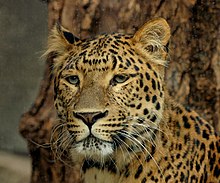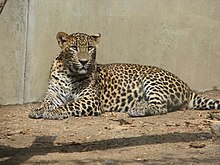Lleopard
| Panthera pardus | |
|---|---|
 Panthera pardus pardus | |
| Dades | |
| Període de gestació | 91 dies i 1 |
| Principal font d'alimentació | ungulats i primat |
| Longevitat màxima | 27,3 anys |
| Hàbitat | matollar i bosc |
| Nombre de cries | 5 |
| Estat de conservació | |
 | |
| Vulnerable | |
| UICN | 15954 |
| Taxonomia | |
| Super-regne | Eukaryota |
| Regne | Animalia |
| Fílum | Chordata |
| Classe | Mammalia |
| Ordre | Carnivora |
| Família | Felidae |
| Gènere | Panthera |
| Espècie | Panthera pardus (Linnaeus, 1758) |
| Nomenclatura | |
| Protònim | Felis pardus |
| Distribució | |







El lleopard (Panthera pardus) és un dels quatre anomenats "moixos grossos" del gènere Panthera (els altres són el lleó, el tigre i el jaguar). Es tracta d'un mamífer carnívor de la família dels felins. També se la pot anomenar pantera quan l'animal presenta un pelatge completament negre. Aquesta variació en el pelatge és deguda a un excés de pigmentació fosca a la pell de l'animal (melanisme).
És un animal solitari, tret de l'època reproductora. El període de gestació dura al voltant de tres mesos i la femella pot tenir de 2 a 6 cadells.[4] Les seves preses favorites són els micos,[5] algunes espècies d'antílops petits o mitjans, zebres i bous.[6] És depredat per Panthera leo, Panthera tigris, Crocodylidae i Canis lupus.[7][8] Cacen només de nit i acostumen a passar el dia endormiscats entre la vegetació, en caus d'altres animals o, més sovint, sobre la branca d'un arbre al qual trepen amb gran agilitat.[9] Són animals solitaris. Solen guardar part de la seva caça als arbres per poder menjar durant uns quants dies.
Els lleopards són un animal freqüent a l'heràldica, per exemple apareixen als escuts de Canadà, Anglaterra, Estònia i Ghana, així com als símbols nacionals de Somàlia o Benin. Té associacions de força i ferocitat, com el lleó, i per això ha estat escollit com a mascota per a la Copa del Món de Futbol de 2010 (un lleopard anomenat Zakumi).
Subespècies
- Panthera pardus delacouri (Pocock, 1930).[10] Des del Sud-est asiàtic fins al sud de la Xina: Bangladesh, el Bhutan, Cambodja, Xina, Laos, Malàisia, Birmània, Tailàndia i el Vietnam[11][12]
- Panthera pardus fusca (Meyer, 1794).[13] Subcontinent indi: Bangladesh, el Bhutan, l'Índia, el Nepal i el Pakistan[11][14][15]
- Panthera pardus japonensis (J. E. Gray, 1862)
- Panthera pardus kotiya (Deraniyagala, 1956)
- Panthera pardus melas (G. Cuvier, 1809)
- Panthera pardus nimr (Hemprich i Ehrenberg, 1833)
- Panthera pardus orientalis (Schlegel, 1857)
- Panthera pardus pardus (Linnaeus, 1758).[16] Àfrica.[11]
- Panthera pardus saxicolor (Pocock, 1927)[1][17][18][2][19][20]
Altres fonts[21] n'esmenten fins a 30 possibles subespècies.
Distribució geogràfica
- És nadiu de l'Afganistan, Algèria, Angola, Armènia, l'Azerbaidjan, Bangladesh, Benín, Bhutan, Botswana, Burkina Faso, Burundi, Cambodja, el Camerun, la República Centreafricana, el Txad, la Xina, la República del Congo, la República Democràtica del Congo, la Costa d'Ivori, Djibuti, Egipte, la Guinea Equatorial, Eritrea, Etiòpia, el Gabon, Gàmbia, Geòrgia, Ghana, Guinea, Guinea Bissau, l'Índia, Indonèsia (Java), l'Iran, Israel, Jordània, Kenya, Corea del Nord, Laos, Libèria, Malawi, Malàisia, Mali, el Marroc, Moçambic, Birmània, Namíbia, el Nepal, el Níger, Nigèria, Oman, el Pakistan, Rússia, l'Aràbia Saudita, el Senegal, Sierra Leone, Somàlia, Sud-àfrica, Sri Lanka, el Sudan, Swazilàndia, el Tadjikistan, Tanzània, Tailàndia, Togo, Turquia, el Turkmenistan, Uganda, els Emirats Àrabs Units, l'Uzbekistan, el Vietnam, el Iemen, Zàmbia i Zimbabue.
- Ha estat extingit a Hong Kong, Kuwait, Líbia, Singapur, Síria i Tunísia.
- La seva presència és dubtosa a l'Irak, el Kazakhstan, el Líban, Corea del Sud, Lesotho i Mauritània.[11]
Referències
- ↑ 1,0 1,1 . Panthera pardus. UICN 2008. Llista Vermella d'espècies amenaçades de la UICN, edició 2008, consultada el 25 març 2010.
- ↑ 2,0 2,1 The Taxonomicon (anglès)
- ↑ uBio (anglès)
- ↑ Eaton, R.L. «Reproductive biology of the leopard». Zoologischer Garten, 47, 5, 1977, pàg. 329–351.
- ↑ Primates: Gorilla Facts – National Zoo| FONZ. Nationalzoo.si.edu. Retrieved on 2012-08-21.
- ↑ Schaller, G. Serengeti: a kingdom of predators. New York: Knopf, 1972. ISBN 0-394-47242-X.
- ↑ Guggisberg, C., 1975. Wild Cats of the World. Nova York: Taplinger Publishing Company.
- ↑ Animal Diversity Web (anglès)
- ↑ Burton, Maurice; Burton, Robert. International Wildlife Encyclopedia (en anglès). vol.11 (leopard - marten). Marshall Cavendish, 2002, p. 1444. ISBN 0761472770.
- ↑ Mammal Species of the World (anglès)
- ↑ 11,0 11,1 11,2 11,3 UICN (anglès)
- ↑ BioLib (anglès)
- ↑ Mammal Species of the World (anglès)
- ↑ www.nic.funet.fi (anglès)
- ↑ BioLib (anglès)
- ↑ Mammal Species of the World (anglès)
- ↑ ITIS
- ↑ «Panthera pardus». Catalogue of Life. (anglès)
- ↑ Mammal Species of the World (anglès)
- ↑ BioLib (anglès)
- ↑ Leopard a Cambridge Encyclopedia
Bibliografia
- Abdoli, A., Ghadirian, T., Khaleghi Hamidi, A., Mostafavi, H., Moshiri, H., Pour'salem, S. i Ghoddousi, A., 2008. Photo of a Persian leopard from Khaeez area in southern Iran. Cat News 48: 14.
- Akkiev, M. I. i Mokaev, A. B., 2006. The leopard (Felidae, Carnivora) in Kabardino-Balkarian Republic (Central Caucasus), its historical and modern status. A: E. P. Kononenko (ed.), Ecological issues of mountainous areas, p. 9-13. KMK, Moscou, Rússia.
- Alekpérov, K. M., 1966. Mammals of south-western Azerbaidjan. Azerb. SSR Acad. Sci. Press, Bakú, Azerbaidjan.
- Anònim. 2007. Amur leopard remains on the brink of extinction. Cat News 46: 51.
- Arabuli, A. B., 2006. On distribution of the leopard (Panthera pardus ciscaucasica) in the southern Caucasus (Georgia). Zoologicheckii zhurnal 85: 910-912.
- Breitenmoser, U., 2006. 7th Conservation Workshop for the Fauna of Arabia 19-22 February: Workshop report. Breeding Center for Endangered Arabian Wildlife, Sharjah, els Emirats Àrabs Units.
- Breitenmoser, U., Breitenmoser-Wursten, C., Morschel, F., Zazanashvili, N. i Sylven, M., 2007. General conditions for the conservation of the leopard in the Caucasus. Cat News Special Issue Núm. 2: 34-39.
- Breitenmoser, U., Mallon, D. i Breitenmoser-Wursten, C., 2006. A framework for the conservation of the Arabian leopard. Cat News Special Issue 1: 44-47.
- Busby, G. B. J., Gottelli, D., Durant, S., Wacher, T., Marker, L., Belbachir, F., de Smet, K., Belbachir-Bazi, A., Fellous, A. i Belghoul, M., 2006. A Report from the Sahelo Saharan Interest Group - Parc National de l'Ahaggar Survey, Algeria (March 2005). Part 5: Using Molecular Genetics to study the Presence of Endangered Carnivores.
- Corbet, G.B. i Hill, J.E. 1991. A World List of Mammalian Species. Tercera edició. Natural History Museum Publications i Oxford University Press, Londres i Oxford: v-viii, 1-243.
- Cuzin, F., 2003. Les grands mammifères du Maroc méridional (Haut Atlas, Anti Atlas et Sahara): Distribution, Ecologie et Conservation. Ph.D. Thesis, Laboratoire de Biogéographie et Ecologie des Vertèbrés, Ecole Pratique des Hautes Etudes, Université Montpellier II.
- DeBlase, A.F., 1982. Mammalia. A: Parker, S.P., Synopsis and Classification of Living Organisms, vol. 2. McGraw-Hill, Nova York: 1015-1061.
- Farhadinia, M., Nezami, B., Mahdavi, A. i Hatami, K., 2007. Photos of Persian leopard in Alborz mountains, Iran. Cat News 46: 34-35.
- Grassman Jr., L. I., 1998. Ecology and behavior of the Indochinese leopard (Panthera pardus delacouri) in a subtropical evergreen forest in southern Thailand. Societa Zoologica La Torbiera, UICN.
- Habibi, K., 2003. Mammals of Afghanistan. Zoo Outreach Organisation/ USFWS, Coimbatore, l'Índia.
- Hunter L., Henschel, P. i Ray, J. C. Panthera pardus. A: J. S. Kingdon i M. Hoffmann (eds), The Mammals of Africa, Academic Press, Amsterdam, els Països Baixos.
- Joslin, P. i Shoemaker, A. H., 1988. Leopards (Panthera pardus) in Iran. International Leopard Studbook, p. 13. Riverbanks Zoological Park, Columbia, els Estats Units.
- Khorozyan I. G. i Abràmov A. V., 2007. The leopard, Panthera pardus (Carnivora: Felidae), and its resilience to human pressure in the Caucasus. Zoology in the Middle East 41: 11-24.
- Khorozyan, I. G., Guennadi, F., Baríxnikov, G. F. i Abràmov, A. V., 2006. Taxonomic status of the leopard, Panthera pardus (Carnivora, Felidae) in the Caucasus and adjacent areas. Russian Journal of Theriology 5(1): 41-52.
- Khorozyan, I., Malkhasyan, A. i Asmaryan, S., 2005. The Persian leopard prowls its way to survival. Endangered Species Update 22: 51-60.
- Kiabi, B. H., Dareshouri, B. F., Ghaemi, R. A. i Jahanshahi, M., 2002. Population status of the Persian Leopard (Panthera pardus saxicolor, Pocock, 1927) in Iran. Zoology in the Middle East 26: 41-47.
- Kittle, A. i Watson, A., 2007. How many leopards are in Sri Lanka?: An estimate from field investigations. The Leopard Project, The Wilderness and Wildlife Conservation Trust.
- Leyhausen, P., B. Tonkin. 1979. Cat Behavior: The Predatory and Social Behavior of Domestic and Wild Cats. Nova York i Londres: Garland STPM Press.
- Lukarevsky, V., 2001. The leopard, striped hyena and wolf in Turkmenistan. Signar Publishers, Moscou, Rússia.
- Lukarevsky, V., Malkhasyan, A. i Askerov, E., 2007. Biology and ecology of the leopard in the Caucasus. Cat News 2: 4-8.
- Mizutani, F., P. Jewell. 1998. Home-range and movements of leopards (Panthera pardus) on a livestock ranch in Kenya. Journal of Zoology, 244: 269-286.
- Nowell, K., 2007. Asian big cat conservation and trade control in selected range States: evaluating implementation and effectiveness of CITES Recommendations. TRAFFIC International, Cambridge, el Regne Unit.
- Nowell, K. i Jackson, P., 1996. Wild Cats. Status Survey and Conservation Action Plan. IUCN/SSC Cat Specialist Group, Gland, Suïssa i Cambridge, el Regne Unit.
- Ray, J. C., Hunter, L. i Zigouris, J., 2005. Setting conservation and research priorities for larger African carnivores. Wildlife Conservation Society, Nova York.
- Sanderson, I., 1972. Living Mammals of the World. Garden City, Nova York: Doubleday i Company.
- Shakula, V., 2004. First record of leopard in Kazakhstan. Cat News 41: 11-12.
- Singh, H. S., 2005. Status of the leopard Panthera pardus fusca in India. Cat News 42: 15-17.
- Singh, U.S., Singh, R., Satyanarayan, K. i Seshamani, G., 2008. Conservation and science: human-leopard conflict study in Jammu and Kashmir, India, to bridge the gap between community and wildlife. Annual meeting of the International Congress for Conservation Biology, Convention Center, Chattanooga, TN.
- Sludsky, A. A., 1973. Distribution and number of wild cats in the USSR. Trudy Instituta zoologii AN KazSSR 34: 5-106.
- Spalton, J. A. i Al Hikmain, H. M., 2006. The leopard in the Arabian peninsula - distribution and subspecies status. Cat News 1: 4-8.
- Spong, G., Johansson, M. i Bjorklund, M., 2000. High genetic variation in leopards indicates large and long-term stable effective population size. Molecular Ecology 9: 1773-1782.
- Sunquist, M. i Sunquist, F., 2002. Wild Cats of the World. University of Chicago Press.
- Uphyrkina, O., Johnson, W. E., Quigley, H. B., Miquelle, D. G., Marker, L., Bush, M. E. i O'Brien, S. J., 2001. Phylogenetics, genome diversity and origin of modern leopard, Panthera pardus. Molecular Ecology 10: 2617.
- Wozencraft, W.C., 1993. Order Carnivora. A: Wilson, D.E. i Reeder, D.M. (eds.) Mammal Species of the World. Segona edició. Smithsonian Institution Press, Washington DC i Londres: 279-348.
Enllaços externs
- NCBI (anglès).
- ARKive (anglès).
- CalPhotos (anglès).
- Walker's Mammals of the World (anglès).
- ZipCodeZoo (anglès).
- Encyclopedia of Life (anglès).
- Discover Life (anglès).



